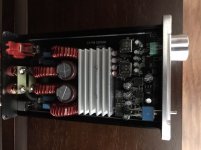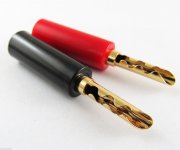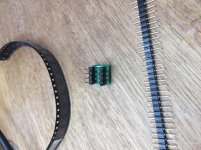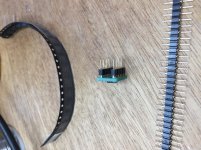Does anyone know the size of the jacks on the AIYAMA TPA3251? I did not realize these jacks were some miniature type. I am trying to order plugs that fit and can't figure out the correct ones to specify.
Do you mean the Speaker connectors / banana plugs ? or DC plug ?
If yes, these ones from Pro Signal are really great and thin
https://fr.farnell.com/pro-signal/psg03031/terminal-post-black/dp/3384009
If yes, these ones from Pro Signal are really great and thin
https://fr.farnell.com/pro-signal/psg03031/terminal-post-black/dp/3384009
Does anyone know the size of the jacks on the AIYAMA TPA3251? I did not realize these jacks were some miniature type. I am trying to order plugs that fit and can't figure out the correct ones to specify.
Standard 4mm Banana Plugs. Cheap on ebay. I like these.
Attachments
I personnaly use these ones and work fine with my Aiyima amplifier :
AmazonBasics Lot de 24 fiches bananes plaquees or 24 carats (12 rouges et 12 noires): Amazon.fr: High-tech
AmazonBasics Lot de 24 fiches bananes plaquees or 24 carats (12 rouges et 12 noires): Amazon.fr: High-tech
Standard banana plugs or bare wire connections will work best with the smaller binding posts. Large spades won’t work and you risk shorting the speaker outputs and killing the amp.
Note;
FWIW, I ordered the suggested OPA 1656 from the USA seller in an earlier post The seller notes the pin diameter will not be accepted by all sockets due to pin diameter.
Correct, The OP Amp pins will fit in the Aiyima sockets , just barely in. The amp works but if it got jarred pretty good you would have to reseat them .
QUOTE=daniboun;6272792]Sure, from USA :
DIP8 OPA1656 Ultra-Low-Noise Low-Distortion FET-Input Audio Operational Amplifie | eBay
From Europe :
OPA1656 SoundPlus™ ultra-low noise and distortion, Burr-Brown™ audio opamp | eBay[/QUOTE]
FWIW, I ordered the suggested OPA 1656 from the USA seller in an earlier post The seller notes the pin diameter will not be accepted by all sockets due to pin diameter.
Correct, The OP Amp pins will fit in the Aiyima sockets , just barely in. The amp works but if it got jarred pretty good you would have to reseat them .
QUOTE=daniboun;6272792]Sure, from USA :
DIP8 OPA1656 Ultra-Low-Noise Low-Distortion FET-Input Audio Operational Amplifie | eBay
From Europe :
OPA1656 SoundPlus™ ultra-low noise and distortion, Burr-Brown™ audio opamp | eBay[/QUOTE]
Note;
FWIW, I ordered the suggested OPA 1656 from the USA seller in an earlier post The seller notes the pin diameter will not be accepted by all sockets due to pin diameter.
Correct, The OP Amp pins will fit in the Aiyima sockets , just barely in. The amp works but if it got jarred pretty good you would have to reseat them .
QUOTE=daniboun;6272792]Sure, from USA :
DIP8 OPA1656 Ultra-Low-Noise Low-Distortion FET-Input Audio Operational Amplifie | eBay
From Europe :
OPA1656 SoundPlus™ ultra-low noise and distortion, Burr-Brown™ audio opamp | eBay
Your OPA1656 Op Amps have square pins, right ?
Rob43
The seller sent an email after shipping that the pins would not fit in some sockets due to their 0.68mm diameter.
They felt square although I will take the amp cover off tomorrow , remove one and look at the pins with my magnifying setup
They felt square although I will take the amp cover off tomorrow , remove one and look at the pins with my magnifying setup
All adapters used for the Op-Amps should have round turned pins !
Only cheapskate venders will try to save a few fractions of dollars by providing the square pin legs on their adapters. These are designed to be soldered into the circuit board - Not for use in sockets !!
You will very likely damage the sockets if you use the square pin adapters !
Here are some pictures of the round turned pin ones.
Only cheapskate venders will try to save a few fractions of dollars by providing the square pin legs on their adapters. These are designed to be soldered into the circuit board - Not for use in sockets !!
You will very likely damage the sockets if you use the square pin adapters !
Here are some pictures of the round turned pin ones.
Attachments
Your OPA1656 Op Amps have square pins, right ?
Rob43
I need to check since they are mounted and soldered on SOIC > DIP8 adapter.
The seller sent an email after shipping that the pins would not fit in some sockets due to their 0.68mm diameter.
They felt square although I will take the amp cover off tomorrow , remove one and look at the pins with my magnifying setup
I need to check since they are mounted and soldered on SOIC > DIP8 adapter.
Hi Danny. If they are the Op-Amps that I supplied to you all the ones I make up are with good quality round Turned Pins as in the photographs above.
What capacitor to change to tame the HF?
The input electrolyt 10uF?
Solve,
The HF can be a touch bright and grainy with the Aiyima A04 TPA3251 amp. I assume this is the amp you are referring to. By replacing the stock op amps with better ones, everything fell in place in terms of tonal balance and smoothness. I have not felt any need to replace the stock input caps since then.
I would also recommend using your choice of solder and touch up all the solder joints in the signal path including the input caps. I am not sure what solder the manufacturer used, but it doesn’t flow like a good Kester 44 or Cardas quad eutectic solder. I found the best thing was to suck the old solder off with a touch of solder flux paste and then apply new solder. It sounds a bit over the top, but this alone can make a significant difference in sound quality. It almost seems like Chinese manufactured audio electronics is chock full of sub-quality solder joints.
Yes I can higly recommend bushellj OPA1656 adapter ! I am really happy with those he provided me )
Solve,
The HF can be a touch bright and grainy with the Aiyima A04 TPA3251 amp. I assume this is the amp you are referring to. By replacing the stock op amps with better ones, everything fell in place in terms of tonal balance and smoothness. I have not felt any need to replace the stock input caps since then.
I would also recommend using your choice of solder and touch up all the solder joints in the signal path including the input caps. I am not sure what solder the manufacturer used, but it doesn’t flow like a good Kester 44 or Cardas quad eutectic solder. I found the best thing was to suck the old solder off with a touch of solder flux paste and then apply new solder. It sounds a bit over the top, but this alone can make a significant difference in sound quality. It almost seems like Chinese manufactured audio electronics is chock full of sub-quality solder joints.
It's 3e Audio 4 channel and replaced two of them to OPA1656 to try.
Only running two channel now and those input caps looks cheap and it's a little to much harchness with OPA1656 compared to orginal RC4580 which
sounds softer in top.
But more overall clarity with OPA1656.
My Burson V5i-D dual op amps arrived today and I installed these in my Aiyima A04 TPA3251 Class D amp. I’ve been enjoying the Burr Brown OPA627AU op amps in my amp for a while now, and I’m letting these Burson op amps burn in, but I am very impressed with what I hear. These op amps seem to really resolve the soundstage better with musicians in their own spaces in the mix.

The OPA627AU op amps have a really organic midrange, and maybe a little more forward midrange than some might prefer. The Burson op amps provide a better balance in frequencies from top to bottom. The midrange is a little “less in your face” so to speak. I’m definitely going to keep these op amps in the Aiyima amp. They kind of look cool with the silk screened metal cases.

The OPA627AU op amps have a really organic midrange, and maybe a little more forward midrange than some might prefer. The Burson op amps provide a better balance in frequencies from top to bottom. The midrange is a little “less in your face” so to speak. I’m definitely going to keep these op amps in the Aiyima amp. They kind of look cool with the silk screened metal cases.
I share the same but found OPA1656 better than the V5i ...
It is probably a question of taste )
It is probably a question of taste )
Finally decided to join the Aiyima A04 bandwagon and was wondering about swapping the opamps it comes with.
How do I remove the original ones from the board exactly? My fat fingers can't seem to get the job done 😀
Would you recommend using a pair of long nose or needle pliers? They usually come off easy or do I risk damaging anything?
Cheers,
David
How do I remove the original ones from the board exactly? My fat fingers can't seem to get the job done 😀
Would you recommend using a pair of long nose or needle pliers? They usually come off easy or do I risk damaging anything?
Cheers,
David
I use a stainless steel dental pick tool, but you can probably use a safety pin to wedge underneath the outermost op amp first. Once you get that one out of the way, you should be able to access the innermost one.
- Home
- Amplifiers
- Class D
- TPA3251d2


